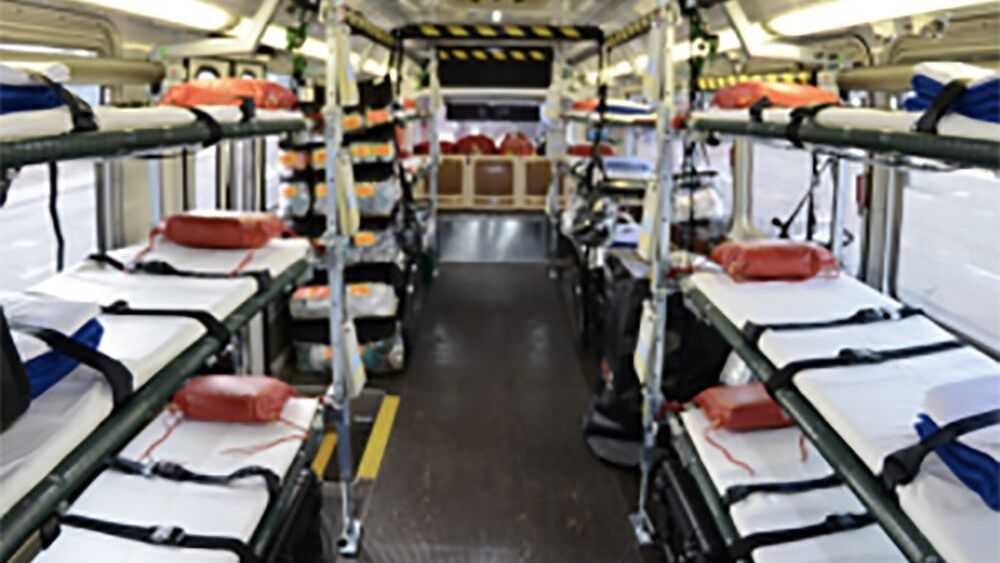Sponsored by First Line Technology
By Yoona Ha, EMS1 BrandFocus Staff
Hurricanes, earthquakes, floods and wildfires strike communities across the country every year, damaging homes and displacing thousands. The response to Hurricane Katrina has been a lesson for many EMS workers, who recognized the importance of better disaster preparedness.
Ideally, every EMS agency should be ready to spring into action when disaster hits. But as the NAEMT National Survey on EMS Preparedness for Disaster and Mass Casualty Incident Response revealed, there are significant gaps in EMS preparedness for response to natural and manmade disasters and mass casualty incidents.
The biggest obstacle to EMS preparedness is lack of funding, according to 75 percent of the survey’s respondents. The reality is that some agencies don’t have enough resources to secure the tools they need to facilitate a fast and effective response.
To help agencies get the resources they need, companies like First Line Technology have worked to find new ways to support agencies that need all the help they can get. What’s a cost-effective solution to evacuating, transporting and caring for non-ambulatory patients?
We spoke to Jason Croson, a product manager at First Line Technology, about the tools agencies need to consider to be prepped for the frontlines of disasters and mass casualty incidents.
Responding to the need for consistent disaster preparedness training
One of the key areas of need among EMS providers identified in the preparedness survey was consistent training and support to have a prepared response plan in case the worst happens.
Croson encourages EMS managers to think about their agency’s capacity to respond to a mass casualty incident and identify possible weak spots.
“We hear it often, where agencies in small, rural areas think that disasters won’t strike. We don’t see those happen every day but that’s the whole point,” said Croson. “Thinking outside the box is about asking yourself, What if a disaster happens? Do you have the resources to manage it?”
The consequence of not having an effective disaster preparedness plan is far greater than your agency’s reputation, especially when lives are on the line.
Croson helps first responders develop an action plan for the unexpected, which often involves thinking about partnering with multiple agencies, such as your local health system, neighbouring county EMS agencies and other public health entities. Getting other community partners involved is critical because mass casualty incidents quickly deplete the pool of ambulance vehicles available, which can hamper an agency’s response to the incident and other medical emergencies.
By encouraging agency leaders to think ahead on these issues and by offering training opportunities that involve developing an emergency preparedness plan, First Line Technology is working to continue the conversation.
How the AmbuResponse approach helps agencies maximize available resources
First Line Technology’s AmbuResponse products are designed with mass casualty transport and response in mind. One missed opportunity that First Line Technology addresses is helping agencies make the most of existing transportation resources, like city buses, school buses, trucks and shipping containers.
“During Hurricane Katrina, we saw buses submerged under water when they could have been instead used to address the shortage of ambulances in the region,” Croson said.
That’s where the AmbuBus Kit can come in handy. It’s a flexible and scalable kit that can turn buses into vehicles that can transport that can transport at-risk, non-ambulatory patients. These kits cost a fraction of the price of additional ambulances or medical ambulance buses.
The AmbuBus solution is great for communities that want to use the kit to transform a vehicle at a moment’s notice. The kit comes in a flat, easy-to-store package which includes two frames that can quickly convert a bus into an ambulance bus capable of transporting 18 stretchers and IVs with six operators and their medical support equipment.
Many communities build and deploy at least one permanently assembled Ambubuses to have mass casualty transport capacity for incidents where there is little or no advanced warning. These communities also store additional AmbuBus kits for incidents like hurricanes and floods when there is time to outfit additional buses.
Although it sounds like a lot to sort through and assemble, the kit requires no additional tools and comes with clear instructions on how to get started. It’s a two-person installation job that takes less than two hours to install.
The kit is versatile enough to be used on demand in vehicles or as a free-standing solution when you need a makeshift tent or shelter space in areas with limited floor space. First Line Technology’s suite of AmbuResponse products includes other EMS transport tools and accessories like a medical bag that makes it easier to transport medical equipment a mass casualty oxygen system and a modular wheelchair package.
Don’t let your agency fall behind in disaster preparedness. There’s never a bad time to prepare for a crisis. Get the tools you need now and know how to organize those resources so you know exactly where they are when you need them most.












